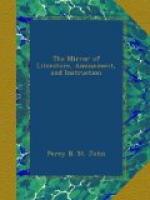Title: The Mirror of Literature, Amusement, and Instruction, No. 574 Vol. XX, No. 574. Saturday, November 3, 1832
Author: Various
Release Date: November 10, 2004 [EBook #14010]
Language: English
Character set encoding: ASCII
*** Start of this project gutenberg EBOOK the mirror of literature, ***
Produced by Jonathan Ingram, David Garcia and the
PG Online
Distributed Proofreading Team.
THE MIRROR OF LITERATURE, AMUSEMENT, AND INSTRUCTION.
Volume XX, no. 574.] Saturday, November 3, 1832. [Price 2d.
* * * * *
[Illustration: Lydford bridge.]
LYDFORD BRIDGE.
This is an interesting scene from the wild and wonderful in Nature. Its romantic luxuriance must win the attention of the artist, and the admiration of the less wistful beholder; while the philosophic mind, unaccustomed to vulgar wonder, may seek in its formation the cause of some of the most important changes of the earth’s surface. Our esteemed friend and correspondent Vyvyan, is probably familiar with the locality of Lydford: his fancy might people it with pixies, and group its scenery into a kind of topographical romance; probably not unaided by its proximity to Dartmoor.[1]
Lydford is situated about seven miles north of Tavistock. It is, in the words of its topographers,[2] a poor decayed village, consisting of rude cottages. It was formerly a place of importance: for in Domesday Book, it is rated in the same manner and at the same time with London. Some remains of its ancient importance may still be seen in a square tower, or keep of a castle, which was formerly used as a court and a prison, where those criminals were tried and confined, who offended against the Stannary Laws. This building is alluded to by William Browne[3]—
They have a castle on a hill;
I took it for an old windmill,
The vane’s blown off
by weather;
To lie therein one night, its guest,
’Twere better to be ston’d
and prest,
Or hang’d—now
choose you whether.
The scenery round the village is singularly picturesque: one of its most prominent objects, The Bridge is represented in the Engraving. It bears great analogy, in situation and character, to the celebrated Devil’s Bridge in Wales. It consists of one rude arch, thrown across a narrow, rocky chasm, which sinks nearly eighty feet from the level of the road. At the bottom of this channel the small river Lyd is heard rattling through its contracted course. The singularity of this scene is not perceived in merely passing over the bridge: to appreciate its character, and comprehend its awfully




